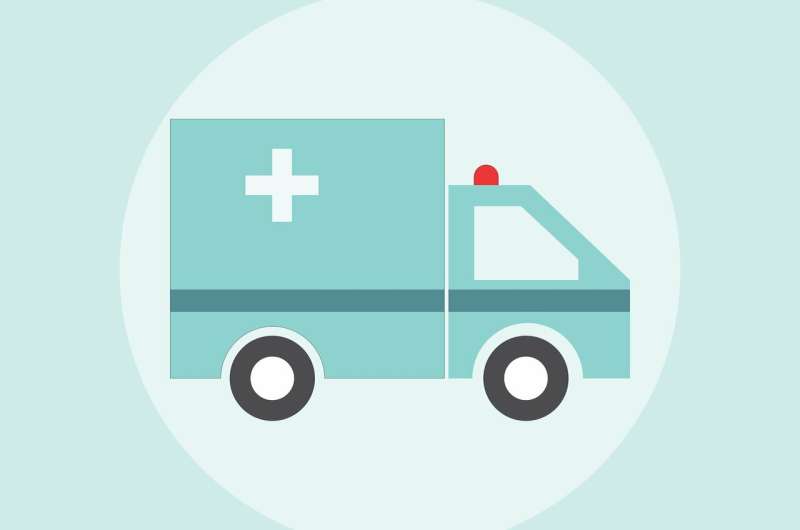Over half of ED visits for nonmedical prescription drug use are patients under 35

Nonmedical prescription drug use is a common cause of emergency department (ED) visits in the United States for medication-related harm, but data on effects of nonmedical use of pharmaceuticals are limited. Using nationally representative public health surveillance data to characterize US ED visits for harm caused by nonmedical prescription drug use, investigators at CDC and FDA report in the American Journal of Preventive Medicine that over half these visits are by young adults under 35, and over 40 percent of patients arrive unconscious or after cardiorespiratory failure. They include recommendations to guide prevention efforts.
Nonmedical prescription drug use, generally defined as use without a prescription or use for reasons other than for which the medication is intended, is a global concern. The increase in morbidity from prescription opioids has been called an epidemic, and overdoses from both prescription and illicit opioids led the US Department of Health and Human Services (HHS) to declare a public health emergency in 2017.
Previous studies have shown that prescription opioids and benzodiazepines are commonly misused (by 11.5 million and 5.6 million individuals in the US, respectively, in 2016). However, since discontinuation of the Drug Abuse Warning Network after 2011, detailed national data describing morbidity from nonmedical use of pharmaceuticals are limited.
The investigation, led by Andrew Geller, MD, Division of Healthcare Quality Promotion, Centers for Disease Control and Prevention (CDC), Atlanta, GA, USA, reviewed data from a nationally-representative data source, the National Electronic Injury Surveillance System-Cooperative Adverse Drug Event Surveillance project, to identify the medications with the highest numbers of ED visits for harms following nonmedical use of medications and identify patients at greatest risk.
Findings from this study quantify how often prescription opioids, benzodiazepines, and other medications cause ED visits after nonmedical use, either alone or in combination. In the US, harm from nonmedical use of pharmaceuticals led to about 360,000 ED visits in the US in 2016, most frequently benzodiazepines and opioids, most commonly in combinations with other substances such as illicit drugs and alcohol. The adverse effects of nonmedical use of medications were frequently serious, with nearly one-quarter of patients unresponsive or experiencing cardiorespiratory failure, and two-fifths of patients requiring hospitalization. There are also concerns about nonmedical use of non-benzodiazepine sleeping aids, stimulants, cough and cold products, and gabapentinoids.
The data showed that in the US in 2016, there were an estimated 358,247 ED visits for harms from nonmedical use of medications.
- Two-fifths (41 percent) of these ED visits resulted in hospitalization, and nearly one-quarter (22.6 percent) of visits involved patients who were unresponsive or had experienced cardiorespiratory failure.
- One half (50.9 percent) of these visits involved patients younger than 35 years of age. Only one in twenty (4.9 percent) visits involved older adults (aged 65 or more years old).
- Benzodiazepines were the most commonly implicated medication (47 percent), followed by prescription opioids (36 percent).
- Other substances such as alcohol, heroin, cocaine, and other illicit substances, or medications were involved in 85 percent of benzodiazepine cases and 69 percent of prescription opioid cases.
The investigators point out that although patients treated for nonfatal overdose have increased risk of another overdose, naloxone, which has shown efficacy in tertiary prevention of fatal opioid overdoses, is not routinely made available to overdose patients at ED discharge. They propose that efforts to expand naloxone distribution could initially target patients who receive emergency care for serious overdose symptoms. In addition, the ED can be a place to begin secondary preventive interventions, such as brief motivational interviewing, connecting patients to peer navigators for follow-up, and linking to or initiating medication-assisted treatment.
Because other substances and additional pharmaceuticals are most often involved, prescribing clinicians should consider implementing specific screening to address polysubstance use and, when warranted, treatment interventions.
For patients, family members, and healthcare providers, these findings highlight areas in which interventions can likely reduce patient harm. First, patients who have been brought to an ED for overdoses after nonmedical use of opioids (or their family or friends) may be the most appropriate people to offer naloxone.
Preventing an overdose is preferable to rescuing a patient after an overdose, but because ED visits most often involve nonmedical use of combinations of illicit substances, alcohol, and medications, a fully effective harm reduction strategy should include screening and treatment for polysubstance use.
More information: "U.S. Emergency Department Visits Resulting From Nonmedical Use of Pharmaceuticals, 2016," American Journal of Preventive Medicine (2019). DOI: 10.1016/j.amepre.2018.12.009



















